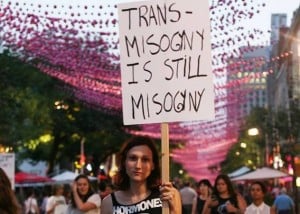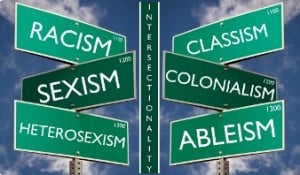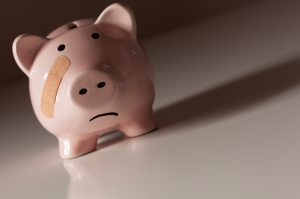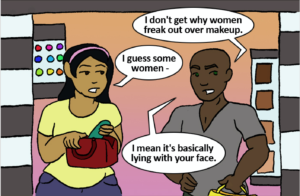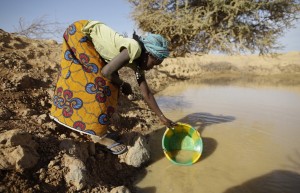
Source: End Water Poverty
I am writing this on Earth Day.
It’s a day that many of us associate with recycling and celebrating trees, wildlife, and rivers. And as a recreational tree-hugger, I can appreciate those traditional connotations of Earth Day.
But today’s environmental issues run much broader than just our waterways and forests.
Examining environmental issues with a feminist lens enables us to see the intersection of gender, socio-economics, and the environment.
The exploration and study of this intersection is formally referred to as eco-feminism.
Although no single definition of it exists, I would define it as a feminism that works to examine how environmental degradation and climate change impact communities and community members based on their socio-economic status and gender.
It’s important that the valuable intersectional perspective of eco-feminism doesn’t get lost amidst the green frenzy on Earth Day.
Women and Global Climate Change
Natural disasters and resource shortages hit impoverished communities first and worst. With women making up an estimated 70% of those living below the poverty line, they are most vulnerable to the impacts of climate change and environmental degradation.
Women living in developing nations tend to be natural resource managers as the gatherers of food, water and firewood. And from a young age, girls traditionally assist their mothers with this work.
As resources become scarcer with decline in the environment’s health, girls are attending less and less school to be able to dedicate more time to finding water, or simply because school fees are no longer available as crop cycles become less predictable.
You can imagine the cycle of poverty that this spawns.
As primary natural resource managers, these women are especially well-equipped to lead environmental mitigation and adaptation efforts.
But due to traditional and patriarchal gender roles that devalue unpaid work like childcare and water retrieval, women’s specialized knowledge in smart and effective climate change adaptation is typically not respected or taken into consideration in most community decision-making processes.
Environmental and Social Injustice in the United States
In our own backyard, low-income communities and communities of color bear the greatest burden of environmental injustice.
Take Mossville, Louisiana as an example.
The small, rural, and predominantly African American town became the site of the highest concentration of vinyl plastic manufacturers in the US, in addition to housing a coal-fired power plant, oil refineries and other chemical production facilities.
Together, these facilities produce more than 4 million pounds of carcinogenic toxic chemicals that end up in the soil, air and water of Mossville. This community’s exposure to these toxins has resulted in grave health impacts, from high incidences of asthma to a cancer epidemic.
It is not a coincidence that these toxic plants were built in a lower-class community of color and not a place like downtown Washington, DC, a place populated by people of privilege and significant socio-political power.
Mossville, Louisiana is a clear cut incidence of environmental racism.
Toxic Injustice
Another alarming instance of environmental and social injustice happening right before our eyes has to do with toxic chemical exposure.
Mounting scientific evidence reveals that chemicals in our air, water and everyday products—from our furniture to our personal care and cleaning products—are harming our reproductive health and fertility.
This is frightening news for those of us that are planning big spring cleaning extravaganzas or like to paint our nails every few weeks.
But what about if you clean houses for a living or work in a nail salon? Your exposure to toxic chemicals is likely to be constant and severe.
Women of color and immigrant women are overrepresented in professions that entail extreme and dangerous exposure to toxic chemicals.
Again, it’s not a coincidence that low-income women of color are disproportionately burdened by toxic chemicals through their jobs, and the eco-feminist lens helps illuminate this reality.
Applying Eco-Feminism on Earth Day and Beyond
The eco-feminism lens is helpful in addressing environmental issues because it allows us the unveil oppressive societal structures – like racism, sexism, and classism – that play a significant role in the health of the environment and who is most impacted by this health declining.
So from now on, when you’re discussing recycling with your friends, don’t just think about where your un-recycled items will end up.
Dig deeper and consider which communities tend to live near the landfills in which non-recyclable waste is dumped.
Then dig even deeper and consider how living near the landfills may impact their health and wellbeing and if they are likely to have access to health insurance or not when it comes time to address these health impacts.
That is the beauty of the intersectional nature of eco-feminism.
[do_widget id=”text-101″]
Sara Alcid is a young feminist living and working in Washington, DC as a reproductive health and justice advocate. Sara loves thinking, reading and writing about the socially and personally transformative power of feminism, queer issues, and women’s health. Follow her on Twitter @SaraAlcid.
Search our 3000+ articles!
Read our articles about:
Our online racial justice training
Used by hundreds of universities, non-profits, and businesses.
Click to learn more








